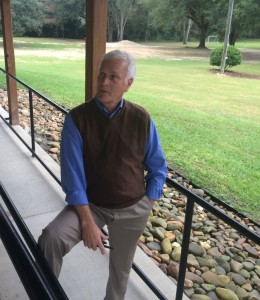Teachers who come to work for Belmont Academy in Lake City, Fla. often see one of the school’s recruitment fliers, illustrated with five words scratched onto a green chalk face: “I just want to teach!”

Michael Cady, the charter school’s principal, said that slogan tends to resonate with teachers who have no interest in working as babysitters or disciplinarians. His school, one of North Florida’s few rural charters, has little need for those.
“I’m going to find teachers who really want to teach,” he said. “I feel like we have loaded this school with teachers like this.”
It’s safe to say the culture is a bit different at Columbia County’s only remaining charter school, thanks in part to its unique origins. The school was started three years ago by a group of home school parents, and administrators say more than half of its roughly 435 students were previously taught at home.
“The advantage of home schooling is, these children learn from adult role models,” Cady said. “When you put them into a classroom, you learn something that soceity learns — that your actions can affect others.”
Before the school’s 2013 founding, home school families banded together, and saw a need for options outside the traditional school system Many of them also felt their children would benefit from the structure of a school where they would have to hew to a schedule and work with larger groups of peers.
“It was a group of parents who saw a need, and saw this will fit the need well,” said Ron Barker, an assistant principal and the school’s music department head. His four children were previously taught at home, but now they go to Belmont.
Parents helped assemble the school’s brick-and-steel building, which Barker said was erected with 80 percent volunteer labor.
The school has short-circuited some of the usual political tensions that surround charter schools, especially in rural communities where students are fewer and budgets are tighter. A new charter that draws hundreds of students, and the associated state funding, away from existing public schools can threaten a district’s bottom line.

According to the Lake City Reporter, the local district was bracing for a financial hit going into the 2013-14 school year, and worried its fiscal cushion would erode below the state-required 3 percent of its general fund as hundreds of students enrolled in the new charter school. But on Oct. 24, 2013, a few months after Belmont opened, a banner headline read: “School finances looking up.”
Bonnie Penner, the finance director for Columbia County schools, told the paper that the school brought more than 190 new students into the public school system, drawing new state funding with them. (Barker said the number may have been even higher higher; administrators count about 260 former home schoolers attending).
“A big concern was that Belmont Academy students would just be our students, and that would be money we would have to pay them,” Penner said, according to the article. “If Belmont had ended up emptying out Columbia Elementary, or any school, this fiscal recovery plan would be a lot different.”
Other parents might have been looking for other school options, but found they didn’t have the time to teach their children themselves.
“You have to be very disciplined to do home school,” Eliza Curry, Belmont’s part-time art teacher, said after showing off sheets of paper her students had manufactured from recycled materials. Curry said she taught 10 children at home herself, and now has grandchildren attending the school.
It’s common for parents and grandparents like Curry, who studied at the Art Institute of Chicago, to contribute to Belmont in some way. Each school year, administrators say they tally between 30,000 and 40,ooo volunteer hours.
“If you can get large numbers of parents who buy into a culture, you can have something that’s pretty dynamic,” said Cady, the principal. “It’s a real level of ownership.”


